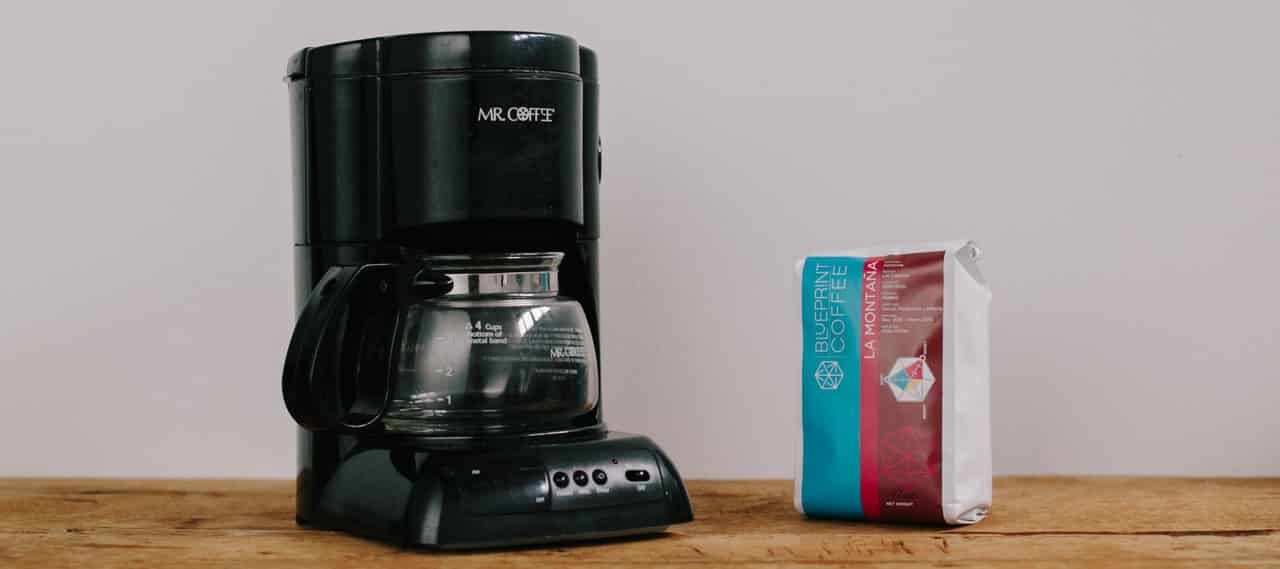Your cart is currently empty!
Brew better at home: Auto-drip (part 1)

Having worked in coffee for almost two years now and a coffee drinker for much longer, customers guess about how I make coffee while not in the cafe. At Blueprint Coffee, our filter coffee options are all manually made on the Hario V60. It’s naturally assumed that I do the same thing at home. On the contrary…
My home setup was involved, with an Aeropress and Bonavita variable temperature kettle. Coffee was ground ahead of time on the shop’s Mahlkoning EK43. Different recipes were utilized (shoutout to Heart Coffee Roasters and their Aeropress recipe), and brews were tossed because they didn’t taste great. The obsessive nature of this was a buzzkill to my weekend. I just wanted to relax and enjoy coffee at home without the added pressure of executing a manual brew. It also was an impediment to spending time with my girlfriend. We couldn’t sit down and have coffee together because I’d be brewing my cup of coffee as she started diving into hers.
Things came to a head, and my girlfriend’s used $5 Mr. Coffee maker was redeployed to the kitchen counter after I had originally banished it to the cupboard. This got me thinking: if I am going to use the Mr. Coffee brewer, I might as well try and make it to the best of my abilities with the skills I use in the cafe. Now, my home coffee routine is pretty straight forward. I warm up the brewer, weigh out the coffee and the water, load it up, push the “on” button and have a pot of coffee a few minutes later.
When customers whose interest in coffee begins to bloom, the biggest variable I speak about is the grinder. I imagine the classic blade grinder and auto-brewer setup is the most common coffee setup at home. Using a solid burr grinder will improve the quality of the coffee the most, and it also doesn’t have to break the bank. You don’t even need to buy a grinder! Just ask your barista to grind the coffee for you for your specific brew device. (Note: we’re always happy to grind coffee at Blueprint!)
To test out my hypothesis and prove how a blade grinder is letting you down, the Mr. Coffee brewer and a blade grinder were brought into the shop for some brews. The plan was to brew a few brews with coffee ground on a blade grinder versus coffee ground on the shop’s EK43.
Several variables were kept consistent to test the coffee extractions on a Mr. Coffee brewer:
• The same coffee was used (Blueprint Coffee’s Mud House exclusive Nicaragua nine days off roast).
• A ratio of 16 to 1 was also used (37 grams coffee to 600 grams water).
• The water was a Reverse Osmosis filtered water from Blueprint’s cafe.
• If you’re a statistician, please don’t write in and get mad about the process. It’s a very small sample size. I’d definitely be curious to see this expanded out over a larger sample size.
Pictures of the experiments and their results are down below.**






By simply buying good coffee beans and having them ground through a burr grinder, the total dissolved solids jumped up by 0.54 on average, and the extraction percentage rose 7.64% on average. The few sips of the blade grinder coffee were quite astringent due to an uneven extraction. The EK43 ground coffee brews tasted more uniform. It is also important to note that the taste quality was not considered in this experiment. Which does lead me to the next part…
There will be a follow up post to this experiment which will focus on the taste quality. The second part will focus on how well coffee pre-ground at the shop tastes as opposed to freshly ground on a home grinder. Tune in soon for the second part!
**One of our readers pointed out that it would be helpful to explain what the TDS and EY (extraction yield) used in the experiments are. This was a good point.
At a basic level, TDS is the strength of your cup of coffee. It is expressed as a percentage of anything except water in your cup of coffee. Most filtered, drip coffee consumed in the US is somewhere in the 1.1o – 1.50% range. TDS is fairly subjective.
Extraction yield is a measurement of how much of the coffee bean/grounds mass has been dissolved into the cup of coffee. This measurement is much more objective and no matter what brewing method is being used, coffees will taste their best around 20% extraction yield.
If you’d like to learn more, Barista Hustle does a great job diving into why.
